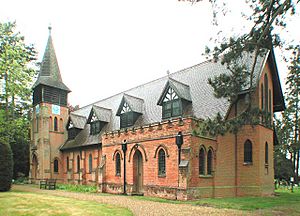St Nicholas Church, Kelvedon Hatch facts for kids
St Nicholas Church is a special place of worship for the Church of England in the village of Kelvedon Hatch, Essex. A "parish church" is like a local church for a specific area. We first learned about this church around the year 1254. Back then, its value was recorded as 6 marks, which increased to 10 marks by 1291, and then to £12 in 1535. These records help us understand its long history.
Contents
A Look Back: The Old Church Buildings
The first St Nicholas Church was a medieval building. It was completely rebuilt in the early 1750s. Even after this big change, some old parts were kept. These included a bell from the 15th century and an eight-sided font, which is a basin used for baptisms. This font also likely dated back to the 1400s.
Why a New Church Was Needed
In 1873, the church had some repairs that cost £380. However, by 1893, most people in the village had moved to a different area. Because of this, people decided to build a brand new church closer to where everyone lived. This new church was built on land that was first meant to be a new village cemetery.
Building the 1895 Church
The new church cost £2000 to build. It was designed by a local architect named John Thomas Newman. This beautiful red brick church was officially opened in 1895. Many items from the older medieval and Georgian churches were moved into the new one. These included the old font, the bell from 1460–1480, and the seating from the 1800s. The church was repaired again in 1927. Today, it is a Grade II listed building, which means it's an important historical structure.
What Happened to the Old Church?
After the new church was built, the original old church was not kept up. It slowly fell apart. Sadly, it was also damaged in 1945 by a special type of bomb used during World War II. Even so, some old parts of the church survived until at least 1956. These included medieval floor slabs and wall monuments from the 16th to 18th centuries. Some of these monuments were for the Wright family, who owned Kelvedon Hall, where the church stood. Others were for the Luther family. The Luther family likely gave the church a silver cup and plate in 1674, which have their family symbol on them.


